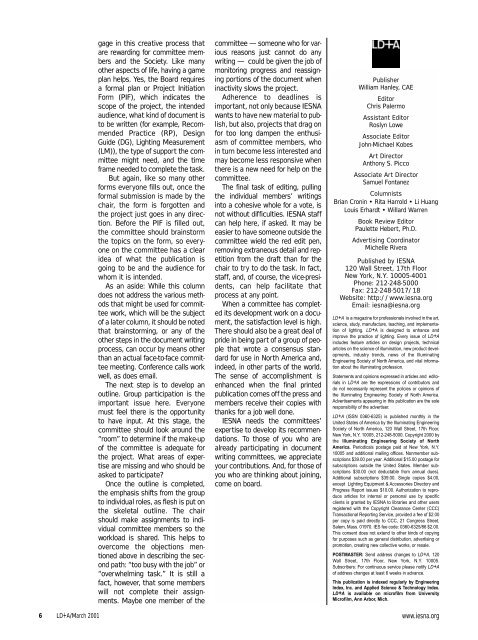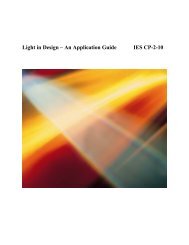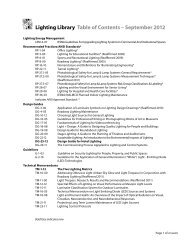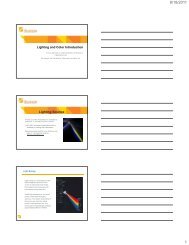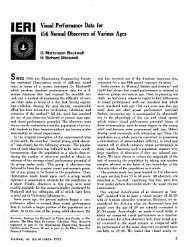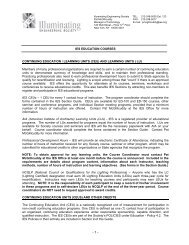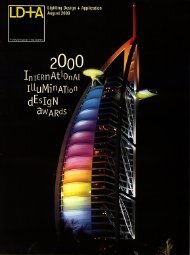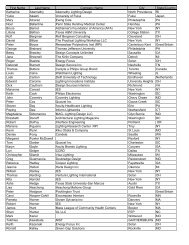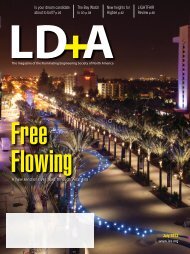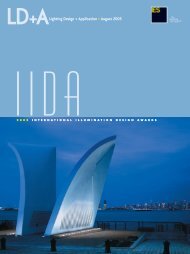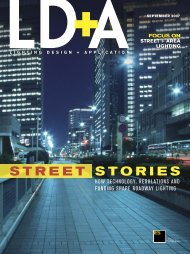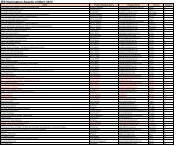contents - Illuminating Engineering Society
contents - Illuminating Engineering Society
contents - Illuminating Engineering Society
Create successful ePaper yourself
Turn your PDF publications into a flip-book with our unique Google optimized e-Paper software.
gage in this creative process that<br />
are rewarding for committee members<br />
and the <strong>Society</strong>. Like many<br />
other aspects of life, having a game<br />
plan helps. Yes, the Board requires<br />
a formal plan or Project Initiation<br />
Form (PIF), which indicates the<br />
scope of the project, the intended<br />
audience, what kind of document is<br />
to be written (for example, Recommended<br />
Practice (RP), Design<br />
Guide (DG), Lighting Measurement<br />
(LM)), the type of support the committee<br />
might need, and the time<br />
frame needed to complete the task.<br />
But again, like so many other<br />
forms everyone fills out, once the<br />
formal submission is made by the<br />
chair, the form is forgotten and<br />
the project just goes in any direction.<br />
Before the PIF is filled out,<br />
the committee should brainstorm<br />
the topics on the form, so everyone<br />
on the committee has a clear<br />
idea of what the publication is<br />
going to be and the audience for<br />
whom it is intended.<br />
As an aside: While this column<br />
does not address the various methods<br />
that might be used for committee<br />
work, which will be the subject<br />
of a later column, it should be noted<br />
that brainstorming, or any of the<br />
other steps in the document writing<br />
process, can occur by means other<br />
than an actual face-to-face committee<br />
meeting. Conference calls work<br />
well, as does email.<br />
The next step is to develop an<br />
outline. Group participation is the<br />
important issue here. Everyone<br />
must feel there is the opportunity<br />
to have input. At this stage, the<br />
committee should look around the<br />
“room” to determine if the make-up<br />
of the committee is adequate for<br />
the project. What areas of expertise<br />
are missing and who should be<br />
asked to participate<br />
Once the outline is completed,<br />
the emphasis shifts from the group<br />
to individual roles, as flesh is put on<br />
the skeletal outline. The chair<br />
should make assignments to individual<br />
committee members so the<br />
workload is shared. This helps to<br />
overcome the objections mentioned<br />
above in describing the second<br />
path: “too busy with the job” or<br />
“overwhelming task.” It is still a<br />
fact, however, that some members<br />
will not complete their assignments.<br />
Maybe one member of the<br />
committee — someone who for various<br />
reasons just cannot do any<br />
writing — could be given the job of<br />
monitoring progress and reassigning<br />
portions of the document when<br />
inactivity slows the project.<br />
Adherence to deadlines is<br />
important, not only because IESNA<br />
wants to have new material to publish,<br />
but also, projects that drag on<br />
for too long dampen the enthusiasm<br />
of committee members, who<br />
in turn become less interested and<br />
may become less responsive when<br />
there is a new need for help on the<br />
committee.<br />
The final task of editing, pulling<br />
the individual members’ writings<br />
into a cohesive whole for a vote, is<br />
not without difficulties. IESNA staff<br />
can help here, if asked. It may be<br />
easier to have someone outside the<br />
committee wield the red edit pen,<br />
removing extraneous detail and repetition<br />
from the draft than for the<br />
chair to try to do the task. In fact,<br />
staff, and, of course, the vice-presidents,<br />
can help facilitate that<br />
process at any point.<br />
When a committee has completed<br />
its development work on a document,<br />
the satisfaction level is high.<br />
There should also be a great deal of<br />
pride in being part of a group of people<br />
that wrote a consensus standard<br />
for use in North America and,<br />
indeed, in other parts of the world.<br />
The sense of accomplishment is<br />
enhanced when the final printed<br />
publication comes off the press and<br />
members receive their copies with<br />
thanks for a job well done.<br />
IESNA needs the committees’<br />
expertise to develop its recommendations.<br />
To those of you who are<br />
already participating in document<br />
writing committees, we appreciate<br />
your contributions. And, for those of<br />
you who are thinking about joining,<br />
come on board.<br />
Publisher<br />
William Hanley, CAE<br />
Editor<br />
Chris Palermo<br />
Assistant Editor<br />
Roslyn Lowe<br />
Associate Editor<br />
John-Michael Kobes<br />
Art Director<br />
Anthony S. Picco<br />
Associate Art Director<br />
Samuel Fontanez<br />
Columnists<br />
Brian Cronin • Rita Harrold • Li Huang<br />
Louis Erhardt • Willard Warren<br />
Book Review Editor<br />
Paulette Hebert, Ph.D.<br />
Advertising Coordinator<br />
Michelle Rivera<br />
Published by IESNA<br />
120 Wall Street, 17th Floor<br />
New York, N.Y. 10005-4001<br />
Phone: 212-248-5000<br />
Fax: 212-248-5017/18<br />
Website: http://www.iesna.org<br />
Email: iesna@iesna.org<br />
LD+A is a magazine for professionals involved in the art,<br />
science, study, manufacture, teaching, and implementation<br />
of lighting. LD+A is designed to enhance and<br />
improve the practice of lighting. Every issue of LD+A<br />
includes feature articles on design projects, technical<br />
articles on the science of illumination, new product developments,<br />
industry trends, news of the <strong>Illuminating</strong><br />
<strong>Engineering</strong> <strong>Society</strong> of North America, and vital information<br />
about the illuminating profession.<br />
Statements and opinions expressed in articles and editorials<br />
in LD+A are the expressions of contributors and<br />
do not necessarily represent the policies or opinions of<br />
the <strong>Illuminating</strong> <strong>Engineering</strong> <strong>Society</strong> of North America.<br />
Advertisements appearing in this publication are the sole<br />
responsibility of the advertiser.<br />
LD+A (ISSN 0360-6325) is published monthly in the<br />
United States of America by the <strong>Illuminating</strong> <strong>Engineering</strong><br />
<strong>Society</strong> of North America, 120 Wall Street, 17th Floor,<br />
New York, N.Y. 10005, 212-248-5000. Copyright 2000 by<br />
the <strong>Illuminating</strong> <strong>Engineering</strong> <strong>Society</strong> of North<br />
America. Periodicals postage paid at New York, N.Y.<br />
10005 and additional mailing offices. Nonmember subscriptions<br />
$39.00 per year. Additional $15.00 postage for<br />
subscriptions outside the United States. Member subscriptions<br />
$30.00 (not deductable from annual dues).<br />
Additional subscriptions $39.00. Single copies $4.00,<br />
except Lighting Equipment & Accessories Directory and<br />
Progress Report issues $10.00. Authorization to reproduce<br />
articles for internal or personal use by specific<br />
clients is granted by IESNA to libraries and other users<br />
registered with the Copyright Clearance Center (CCC)<br />
Transactional Reporting Service, provided a fee of $2.00<br />
per copy is paid directly to CCC, 21 Congress Street,<br />
Salem, Mass. 01970. IES fee code: 0360-6325/86 $2.00.<br />
This consent does not extend to other kinds of copying<br />
for purposes such as general distribution, advertising or<br />
promotion, creating new collective works, or resale.<br />
POSTMASTER: Send address changes to LD+A, 120<br />
Wall Street, 17th Floor, New York, N.Y. 10005.<br />
Subscribers: For continuous service please notify LD+A<br />
of address changes at least 6 weeks in advance.<br />
This publication is indexed regularly by <strong>Engineering</strong><br />
Index, Inc. and Applied Science & Technology Index.<br />
LD+A is available on microfilm from University<br />
Microfilm, Ann Arbor, Mich.<br />
6 LD+A/March 2001 www.iesna.org


